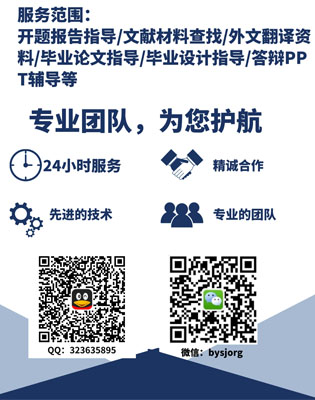第三方征信系统对我国小额贷款的影响分析毕业论文
2021-03-25 22:11:57
摘 要
最近几年移动通信、第三方支付、大数据计算等信息技术不断取得突破性创新,第三方征信服务更为丰富、征信主体范围更广、智能化更强,但其迅速发展的同时也面临着我国互联网征信立法相对滞后、法律难以保障信息主体的权益、互联网金融征信的标准不统一使之难以实现共享等诸多问题与挑战。另一方面,我国小微企业仍受到融资难、融资贵的限制,主要体现在贷款难和贷款贵。信息不对称引发的信用风险是造成小微企业贷款难的关键瓶颈,作为小微企业和低收入群体创业重要融资手段的小额贷款,由于银行的审查成本高、信用风险大而效率较低。
基于国内外对第三方征信和小额贷款的研究成果,本文通过广泛查阅和收集整理相关文献,分别系统地阐述了我国第三方征信系统和小额贷款的发展现状,在此基础上分析了第三方征信体系对我国小额贷款的影响,并以阿里征信为例,客观地分析和明确了第三方征信系统对我国小额贷款产生的影响。通过对以上内容的系统整理、分析、总结和展望,以期对未来我国第三方征信体系的改进提出政策建议。
研究发现:第三方征信可以凭借优异的信息收集与数据挖掘能力,减少信息不对称。完善我国第三方征信系统,并将之引入小额贷款中,有利于提高小额贷款的发放效率和发放额度,并降低小额贷款的风险和成本,进而为中低收入人群和小微企业提供更便捷的贷款通道,解决贷款难的问题。
本文特色:本文提出将具有信息来源丰富、信息收集成本低、效率高等优势的第三方征信,应用于解决小额贷款的信息不对称问题,并对今后如何完善第三方征信体系提出相关政策建议。
关键词:第三方征信; 小额贷款; 信用风险
Abstract
In recent several years, the mobile communication, the mobile payment, big data analysis and other information technology have made breakthrough progress.This progress of internet financial industry is convenient for the third party credit investigation company to collect and analysis.It is also conducive to the improvement of the credit services, the diversification of the credit subjects.At the same time, the third party credit investigation is also facing many challenges, for example, in China, the law of the third party credit investigation is lagging behind and it is hard to protect the personal information. In addition, while the rapid development of the third party credit investigation, China's small companies are facing financing difficulties.In China, the financing difficulties of small enterprises are mainly reflected in the difficulty of obtaining loans, while the credit risk caused by asymmetric information is the key bottleneck for small enterprises.Small loans as important means of financing for micro enterprises and low-income groups, because of the high cost of examination and high credit risk, are low efficiency.
Now based on the research of the third party credit investigation and small loans ,this paper, by reviewing and collecting related literatures, systematically expounded the development of the third party credit system and small loans, then analyzed the influence of the third party credit system on small loans in China. This paper also used alibaba credit investigation as an example to analyze the impact of the three party credit investigation on small loans.
Findings: the third party credit investigation can reduce the information asymmetry by virtue of advanced information collection and data mining capabilities. By improving the third party credit system in our country and using it on small loans, it will improve the efficiency of payment, and reduce the cost and risk of small loans. By the way, it will help low-income people and small companies to solve the small loans' difficulties.
Features: this paper proposes that we can use the advantages of the third party credit investigation, such as the wealth of information sources, the lower cost of information collection and high efficiency, to solve the information asymmetry of small loans. And it also gives some suggestions on how to improve the third party credit reporting system in future.
Key Words:Third party credit investigation; Small loan; Credit risk
目 录
摘 要 I
Abstract II
第1章 绪论 1
1.1 研究背景目的及意义 1
1.1.1 研究背景 1
1.1.2 研究目的及意义 1
1.2 国内外研究现状分析 2
1.2.1 关于第三方征信系统的研究 2
1.2.2 关于小额贷款的研究 3
1.2.3 国内外研究现状评述 3
1.3 研究内容框架和研究方法 3
1.3.1 研究内容框架 4
1.3.2 研究方法 4
第2章 我国第三方征信系统的发展 5
2.1 我国第三方征信系统的发展现状 5
2.1.1 征信行业定义 5
2.1.2 征信机构分布 5
2.1.3 第三方征信的发展现状 5
2.2 我国第三方征信系统的种类 5
2.2.1 P2P网络信贷平台征信 6
2.2.2 电子商务平台征信 6
2.2.3 第三方支付平台征信 6
2.3 第三方征信系统的构建 6
2.4 第三方征信系统的机遇与挑战 6
2.4.1 第三方征信系统的机遇 7
2.4.2 第三方征信系统的挑战 7
第3章 我国小额贷款的发展 9
3.1 小额贷款的定义 9
3.2 小额贷款信用风险的来源 9
3.2.1 小额贷款公司信用风险的生成 9
3.2.2 发展小额贷款面临的问题 10
3.3 小额贷款信用风险的主要防范手段 11
3.3.1 小额贷款的信用风险评价模型 11
3.3.2 通过征信系统防范信用风险 12
第4章 第三方征信对我国小额贷款的影响 13
4.1 第三方征信在小额贷款业务中的作用 13
4.1.1 小额贷款中引入第三方征信的积极意义 13
4.1.2 第三方征信平台对小额贷款的促进机制 13
4.1.3 第三方征信平台对小额贷款的促进效果 14
4.2 第三方征信在实际应用中的不足和政策建议 14
4.2.1 第三方征信在实际应用中的不足 15
4.2.2 对我国第三方征信机构发展的政策建议 15
第5章 分析我国第三方征信系统的应用——以阿里征信为例 16
5.1 阿里征信的构建 16
5.2 阿里征信模式的应用 16
5.3 阿里征信的优势与局限性 17
5.3.1 阿里征信的优势 17
5.3.2 阿里征信模式的局限性 18
第6章 总结 19
参考文献 20
致 谢 21
第1章 绪论
1.1 研究背景目的及意义
1.1.1 研究背景
最近几年,移动通信、电子支付、大数据收集和云计算等信息处理技术不断取得突破性创新。2013年6月余额宝的异军突起导致全国互联网金融产业爆发式增长,互联网金融的迅速革新给第三方征信体系的带来新的机遇和挑战。机遇方面,第三方征信服务的产品更加丰富、征信主体范围扩大、征信系统智能化更加完善。挑战方面,第三方征信机构面临互联网金融征信的立法相对滞后、信息主体的权益保护缺乏法律法规的保障、互联网金融征信信息的标准不统一、征信信息难以在更大范围内共享、互联网金融征信行为的缺少监管主题等问题。
在第三方征信迅速发展时,我国小微企业却面临着融资难、融资贵的困境,这已经成为抑制小微企业健康成长的最大瓶颈。在我国,小微企业的融资难和融资贵主要体现在贷款难和贷款贵,而信息不对称引发的信用风险是造成小微企业贷款难的关键瓶颈。作为小微企业和低收入群体创业重要融资手段的小额贷款,由于银行的审查成本高、信用风险大而效率较低。基于互联网金融的第三方征信正在凭借优异的信息收集与数据挖掘能力,通过建立征信体系减少信息不对称,促进小额贷款的发放,解决低收入群体和小微企业融资难的问题。




